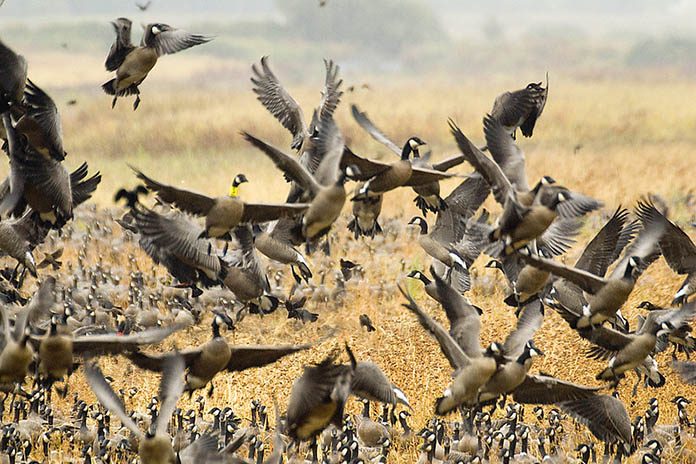
By Lynne Terry/Oregon Capital Chronicle
With the fall migration underway, Oregon officials have noted an increase in birds infected with bird flu.
Oregon Department of Agriculture officials said cases are on the rise, especially among cackling geese in the Willamette Valley. Oregon is the first state to report a spike in infections this fall.
High pathogenic avian influenza was first detected in wild birds in North America in December 2021 and in Oregon in May 2022. Like previous outbreaks of the virus, this one lingered, infecting backyard flocks that come in contact with wild birds and commercial poultry, egg and dairy operations. This week, pigs in a small farm in Crook County that roamed outside also became infected, the first such case in the U.S. One of the animals had the virus throughout its body.
State officials have quarantined the farm and are monitoring it. They indicated that the owners did not become infected.
Recently, nine people in Washington state who work at a commercial poultry operation in Franklin County in southeast Washington became infected through contact with the animals. Oregon health officials said Thursday that three of them traveled to Oregon this week and were monitored by public health officials here. They are now back in Washington and will be monitored by health officials there for 10 days after their exposure.
The Centers for Disease Control and Prevention said Friday there have been nearly 40 cases of bird flu in people nationwide this year, and no one has been hospitalized.
In Oregon this year, officials said there have been nearly 40 outbreaks in backyard flocks, with nearly 130 people exposed. None has been infected.
“At this time, the risk for the general public remains low,” said Melissa Sutton, medical director of viral pathogens at Oregon Public Health. “People who have had close or prolonged, unprotected exposures to infected birds or other animals, or to environments contaminated by infected birds or other animals, are at increased risk of infection.”
The virus often causes mild respiratory symptoms in people and “pink eye,” or conjunctivitis, but it can lead to more severe symptoms and require hospitalization.
The current strain — known as H5N1 — spreads among wild birds, with 10,400 confirmed infections in more than 150 species of birds across the country. Geese are particularly susceptible – especially juveniles – along with raptors, scavengers such as vultures. Ducks are carrier species and spread it to other birds and wetlands.
This strain has also been detected in at least 20 wild mammals, including marine mammals like seals, and scavenger carnivores such as coyotes, foxes and skunks that have likely fed on infected birds. There have been outbreaks among dairy cattle in 14 states, including California and Idaho.
State officials advise residents not to touch any wild animals that become sick or die after eating an infected bird and to report them to the state’s wildlife lab by calling 866-968-2600 or emailing wildlife.health@odfw.oregon.gov. Oregon Department of Fish and Wildlife officials track death and collect tissue samples for testing. If necessary to dispose of the carcass, ODFW officials advise putting it in a grave, taking care to avoid cross-contamination.
Reporter Ben Botkin contributed to this story which first appeared in the Oregon Capital Chronicle.










